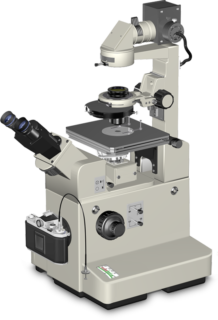Nikon’s Museum of Microscopy
Diaphot Inverted Tissue Culture Microscope
( Circa 1985 )
This workhorse tissue culture microscope features advanced optical design for the shortest, most efficient light path. Incorporated as a part of the built-in turret assembly is a focusable Bertrand lens, photomask reticle and dark slide.

The Diaphot microscope was designed for photomicrography, with photographic capability built into the optical system. The optical design utilizes a built-in binocular body, inclined at 45 degrees, and only one reflecting surface in the microscope body to reduce reflections and glare and maximize image contrast.
Produced during the mid-1980s, the Diaphot was equipped with a Siedentopf-design binocular head built onto a die-cast body. A focusing Bertrand Lens was built into the binocular body for fast alignment of the phase annular ring. A dark slide position was incorporated in the turret to cut off stray light from the optical system during time lapse cinemicrography as well as a low-power focusing magnifier for critically sharp photomicrography with the 2x and 4x objectives.
The stage is located slightly below the binocular head, permitting easy access to and viewing of the specimen area. The coaxial coarse and fine focusing system control the nosepiece, leaving the stage stationary and the specimen exposed for manipulation during observation. Objectives were the last 160-millimeter tube length variety offered by Nikon before the company advanced to infinity-corrected optics.
The Diaphot was supplied with a high-efficiency, 12-volt, 50-watt halogen illuminator. The light path could be switched from 100 percent visual to 20 percent visual/80 percent photo with a lever. Another lever selected either the front photo port for the 35-millimeter camera or the side photo port for large-format photomicrography, cinemicrography, and closed-circuit television (CCTV).
With the addition of a Nikon FE or Nikon F3 camera back, the Diaphot was equipped for automatic exposure 35-millimeter photomicrography. The camera attaches directly onto the "F" bayonet mount at the front of the body. Focusing and composition of the photomicrographs is conveniently accomplished through the binocular head. A lever just below the head is utilized to bring the photomask reticle into the optical path, which is then used to bring the image into focus with the film plane.
Additional accessories for the Diaphot included attachments and objectives for phase contrast, fluorescence, and Nomarski DIC as well as an incubator for environmental control of the specimen area, a cinemicrographic attachment (CFMA), and a CCTV attachment. The side port also accepted Nikon microflex series attachments for use with large-format cameras.
Today Nikon offers a number of different inverted microscope designs.













